
Seven Hills Ranch: About the Property
Scroll down for before & after photos, maps, move-in costs, housing discussion, history of the land, construction impacts, and further details on the proposed development. (For best map and document viewing use laptop or PC.) Click on blue links to access further crucial information. SCROLL ALL THE WAY DOWN FOR BEFORE & AFTER GRAPHICS.



The developer’s proposal:
400 Trees Removed:
Tree removal map 403 trees will be removed for this development, including 350 trees considered “protected” under the County’s own Tree Protection and Preservation Ordinance which states “trees are a vital part of a visually pleasing, healthy environment for the unincorporated area of this county” , and they “provide soil stability, improve drainage conditions, provide habitat for wildlife and provide aesthetic beauty…”. See our map illustrating the type and location of trees to be removed or retained.
The developer states that they will plant 1,100 replacement trees at a 3 to 1 ratio. Most of the replacement trees will be potted or podium plants in courtyards and landscaped areas. These are a weak substitute and certainly not replacements for hundreds-of-years-old, mature, deep rooted, County code-protected trees. Additionally, as much of the site will be occupied by buildings and other infrastructure it becomes obvious that there is insufficient area to accommodate true replacement trees. Developer’s arborist report
Give the existing trees more of a chance at survival by asking the Board of Supervisors to deny the General Plan Amendment. This will keep development reasonable, limit the site’s destruction and consequently allow for greater tree protection.
Hills leveled:
“Cut & Fill” explanation, Bedrock and Soil Removal & Retaining Walls SW, NE, Overview : 6,000 dump trucks full of soil and crushed bedrock will be removed from the site, transported through neighborhoods and down Ygnacio Valley Road. An additional 11,000 dump trucks full of mostly bedrock and some soil will be rearranged during the 3-4 year construction period for the project. The result will be razed or “cut” hills with crushed bedrock and soil pushed in to “fill” in the valleys in defiance of both the County’s Hillside Protection ordinance and its General Plan Open Space Element which discourage “cut & fill” techniques. The County’s General Plan section 9-11 additionally states “…Development on open hillsides and significant ridgelines shall be restricted”.
No explanation is included in the developer plans or the Environmental Impact Report as to how the extensive bedrock being excavated on this site will be crushed, which is an extensive process of its own (see below).
A large-scale system of retaining walls, a mile and a half if laid end-to-end, go from from 5’ to 32’ high (see graphic maps here), and will hold back fill and create huge flat pads to build on. Ironically, all but one hill will be leveled from the Seven Hills Ranch site. See also below “Bedrock Disturbance and Impact”.
Bedrock Disturbance and Impact: Because of the extensive bedrock (solid rock) found at the Seven Hills Ranch site, the project’s bedrock disturbance WILL have SIGNIFICANT impact during the years-long construction process, should the project go through as proposed. Learn more and view Bedrock removal and crushing methods and resultant impacts HERE.
A fascinating graphics/maps portfolio produced for SSHRanch which visually illustrates features of the proposed design: CLICK HERE
We need housing. But is this the housing needed ? This proposal does not fulfill a needed category of the RHNA - Regional Housing Needs Allocation - for Contra Costa County or Walnut Creek.
It’s not “Moderate income” workforce or family housing, it’s a special “Above-Moderate income” (expensive, see below) type of Senior housing, called a Continuing Care Retirement Community (CCRC). Both Contra Costa County and Walnut Creek have fulfilled more than the RHNA required Above-Moderate income category while the Moderate and lower category fulfillment falls short. Additionally, Walnut Creek not only has an abundance of Senior living options, it currently has 524 CCRC units open or opening soon. (174 at Viamonte (open, with vacancy) and 350 more scheduled to open at Oakmont Shadelands). Walnut Creek takes good care of its Above-Moderate income Seniors. What about everyone else? Read MORE HERE and get links to data.
A VERY expensive senior living option:
Look at the “Cost & Fees” for living at the developer’s 'sister' property in Pleasanton, Stoneridge Creek - add an additional 10% for the proposed Walnut Creek development. Entrance fee is from $550K (one bedroom) to 2.7 Million (2 bd. plus) in addition to a monthly "service fee" of between $4,200 to $7,200 (add $40K to the entrance fee and an additional $2,000/mo. when adding a second person to the dwelling). Note: Should you decide to move out or when you pass away, a percentage of your entrance fee is reimbursed, sliding down to 75% reimbursement at five years and after. (see Reimbursement Schedule) One reason for these high costs is that it is a CCRC or Continuing Care Retirement Community, meaning care is provided regardless of your health status, CCRC’s are also called “age-in-place’ developments. NOTE: Because they are calling this a “service” /”non-residential institutional” community and NOT “residential” the developer contends that they do not have to meet state mandates which require a certain percentage of open space be included in the project design. Therefore the 30-acre project has very limited preserved green space. (See Project Description, pg 3, section 2.2.1)
Public Access Denied:
The current 30-acre project proposal includes no public trail nor public access of any kind. The Seven Hills Ranch site is well-suited to accommodate a trail between Heather Farm Park on the east and the Walnut Creek Channel and Iron Horse trail on the west. In fact, the City of Walnut Creek has throughout the years has included and does include such a proposed trail in their planning documents. (WC Trail Proposal HERE) The City’s proposed trail would lead walkers up to the ridgetop’s spectacular view of Mt. Diablo. While public access has never been available to this property that is not unusual for any one-owner private property. However, once a property becomes a multi-residential development municipalities ask developers to join them in their “best practices” and stated General Plan goals of creating permeable communities with accessible green space and with accessibility including options for public walkways. Contra Costa County is no exception with their trails goals found in the County General Plan Ch 9 Open Space Element.
NOT an “Infill” Project:
The developer repeatedly refers to this project as an “infill” project. We contend that this is NOT an “infill” project and its intense development in the proposed manner is in fact contrary to the stated “infill” goals of the California Governor's Office of Planning and Research (OPR). In particular, the OPR’s stated commitment is to “reduce conversion of …sensitive habitat and open space for new development” when considering infill developments. A development proposal is not automatically considered “infill” simply because it is inside the Urban Limit Line (ULL). This 30-acre natural environment as a target for extreme destruction under the banner of “infill” is in fact in direct opposition to many of the OPR’s stated goals and definitions of “infill”. The Spieker EIR continually states this development is proposed for this “urban infill” site . This seriously stretches the concept of urban infill. Generally, “urban” means high rises and densely populated commerce hubs, and “infill” refers to empty or underused lots among urban city blocks. This site is neither, although the proposed development would transform the current suburban area into an urban environment due to its building heights and multiple commercial-type buildings, including a 85,000 square foot Health Care Facility for its residents and the public.
The proposal requires an extreme change in the County’s allowed density:
Here is The Original Real Estate Ad indicating that the property is designated for Single Family Residential - Medium density (3-4.9 units/acre) development; See the entire drone video ad which has great footage of the property. We are asking the County to deny this request for such an extreme change in density and intensity. Sensible, not Supersized.
The current density designation for the site is less than 5 units per acre or 150 total. The new Envision 2040 General Plan designation is for up to 7 units per acre or 210 total. The applicant’s proposal is for more than double that at 14 units per acre for one parcel and almost triple that for the other parcel at 20 units per acre, or 450 total.
The site is next to a park, a school, a suburban low density neighborhood and an HOA community with a density of about 7.5 per acre. Nothing in the surroundings come close to the level of density being asked for in the applicant’s proposal.
The “Saved and Sensible NOT Supersized” Petition:
Our petition gathered over 4,000 signatures, some online, some on paper. Of those, more than three quarters of the signatures are from Walnut Creek addresses, with the remaining coming mainly from Contra Costa County residents. The petition asks that the Board of Supervisors deny the developer’s application for a land use designation change (a General Plan Amendment is needed) and that the property be saved from over-development. The comments signers have included with their signatures are very revealing as to the level of passion people have regarding the extreme change the applicant is asking for and the severe impacts that change will bring.
In general, the concerns mentioned by petition signers most often and how often they were mentioned are: Environmental Impact: 40% of the time, Traffic & noise: 30%, Overdevelopment of the site, Inappropriate for surroundings and General Plan inconsistency were mentioned 40% of the time, and Safety 4%.
Who’s in charge? Walnut Creek has pockets of unincorporated areas which are not part of the city, but are instead under the jurisdiction (laws) of the County. However, because the pockets are close to or surrounded by the City of Walnut Creek properties they are considered in an officially designated “Sphere of Influence” of the City. City representatives can have some say/influence about what occurs in those areas. Since Seven Hills Ranch itself lies within a “sphere of influence” area it is under County authority but has potential to heavily impact Walnut Creek City residents. For this reason, you may still ask that the City’s representatives listen to your concerns and that they express those concerns to the County, even if SHRanch is not in the City and regardless of whether you live in the incorporated (City) or the unincorporated (County) portion of Walnut Creek. Map: Walnut Creek’s Sphere of Influence Speak up: Contact your representatives
The Developer’s Project Description:
451 housing units, 2-story Clubhouse, 3-story Rec Building, 2-story Health Care Center for residents, 1 and 2-story maintenance buildings, parking garage and a total of 519 parking spaces. Although Walnut Creek does not allow gated communities, all 30 acres will be walled with a guard shack at the entrance. Click here for the County website on the proposal.
What Does Save Seven Hills Ranch Want? :
Read HERE the design modifications we feel the developer could make to preserve the integrity of this precious property.
Proposed Development Entry, “Lot A”, and the City of Walnut Creek:
Go to the Proposed Entrance page on this website for further understanding. We are asking the City of Walnut Creek to retain their influence over what happens at Seven Hills Ranch by taking no action on a request from the developer to “sell” a right-of-way for an entrance on Kinross Dr. before the County has acted on the the General Plan Amendment request. Here is both the developer’s request to the City and our public comment on the questionable assumptions in that request: Spieker Irrevocable Offer to City of Walnut Creek, Public Comment re. Irrevocable Offer The WC City Council has stated that they will take no action unless it is in open session and after the County has vetted the project.
Climate Change: This development as proposed would harm Contra Costa County’s efforts to combat climate change, in direct contradiction to the Board of Supervisors Climate Change Emergency Declaration of Sept 22, 2020. If the Spieker proposal is allowed to proceed, it will transform a currently existing beneficial "carbon sink" of over 400 trees that currently store greenhouse gas emissions, into a virtual desert with very little integrated greenspace. The proposal ignores the tremendous opportunity to overlay a beneficial design on the site, one with a reasonable amount of woven green space that removes carbon pollution from the air we breathe. In addition, greenspaces and tree canopy are vital in keeping cities cool. The developer claims they will replace the removed 353 “ protected status trees” (a total of 403 total trees will actually be removed) with 1,078 15-gallon trees. [Project Description pg 9] However, the proposal’s extensive paving and build-over leaves little open area for this number of trees so we question exactly where these trees will be planted to allow their survival.
Air Quality: The extreme grading required for this project will create a high quantity of “Fugitive Dust”. Fugitive dust is dust that “escapes” from a construction site. In this case the dust will likely drift and blanket the adjacent city park, school and homes. Keeping such a large construction site watered down in Walnut Creek’s hot and dry climate, or employing dust control chemicals may not be very effective at dust containment over the 3-4 year construction period. Construction Site Dust Control
Water: 450 new units proposed, California’s 3-Year Drought Continues with No Relief in Sight, 10/4/2022 ; Contra Costa County Water Restrictions, July, 2022 Need we say more?
MORE ABOUT THE EXISTING PROPERTY:
History of Walnut Creek’s Open Space:
Read “The Roots of a Legacy”. A fascinating and inspiring history of those that came before us and not only protected our hillsides from development but purchased, preserved and created the Walnut Creek Open Space for us and all future generations. Walnut Creek Residents and Leaders have a history of protecting the City’s Open Space and Hillsides: Read the ordinance adopted in 1991 to protect these spaces. Note: The public and the City of Walnut Creek’s elected representatives wanted desperately to include Seven Hills Ranch in these protections but the owner and the Building Industry Association of Northern California resisted those efforts.
Conservation of the Property:
There were actual discussions early on between heirs and a conservation group that DID show interest in supporting an effort to preserve the property, back when the owner passed away in 2015. These conversations had a good chance of leading to conservation of some sort. However, the effort got mired in legal technicalities between attorneys and the discussions stalled and ultimately the effort was unsuccessful. That does not mean that there wasn't interest by a conservation group. In addition, there can be little doubt, given the current public response to SSHRanch’s efforts, that if the public had been aware at the time of the preservation possibilities then they would have rallied around such an opportunity and given whole-hearted support to help make it happen.
Wildlife on the Ranch:
Seven Hills Ranch carries the legacy of being the birthplace of Walnut Creek’s immensely popular Lindsay Wildlife Museum/Experience. A young man, Alexander “Sandy” Lindsay, roamed its hills, collecting specimens and injured animals which he cared for in his garage. His passion eventually outgrew the garage and became the first wildlife hospital established in the United States. The Ranch is home to deer, fox, raccoon, possum, skunk, squirrel, snakes, lizards, turtles (they have been observed coming up from the pond at Heather Farm Park to lay and bury their eggs on property next to the ranch), and numerous migratory and native birds such as Owls, Hawks, Woodpeckers and more. Heather Farm Park is an eBird Hotspot where more than 140 species of birds have been observed. No doubt many of these birds take advantage of the nearby ranch’s more that 450 trees, small wetlands, and its creek channel location to broaden their territories. The property’s plentiful oaks provide essential habitat for an abundance of species, as discussed in the California Oaks spring/summer 2021 newsletter and Doug Tallamy’s latest book, The Nature of Oaks: The Rich Ecology of Our Most Essential Native Trees.
The Creek Channel and its Possibilities:
The Walnut Creek channel along the western/southern side of Seven Hills Ranch represents one of the few locations along the concrete channel where creek restoration and wetlands creation are possible. It is a key spot which, through restoration, could offer an essential resting place for fish moving upstream to San Ramon or Las Trampas Creeks. The ranch is a watershed that drains into a small wetlands and directly into the Walnut Creek channel. Read here to understand more about the significant role the Ranch can play in the restoration of the creek channel.
A Bit of Ranch History: Read about the most recent owner, the late Sheridan Hale. And more here. “Sheridan took pride in his excellent stewardship of his land at Seven Hills Ranch Road in Walnut Creek.”
What to expect from the proposed development:

As it is today - view from end of Kinross Drive. Top of new building will be at 180'elevation, 20'- 25' higher than existing hills.
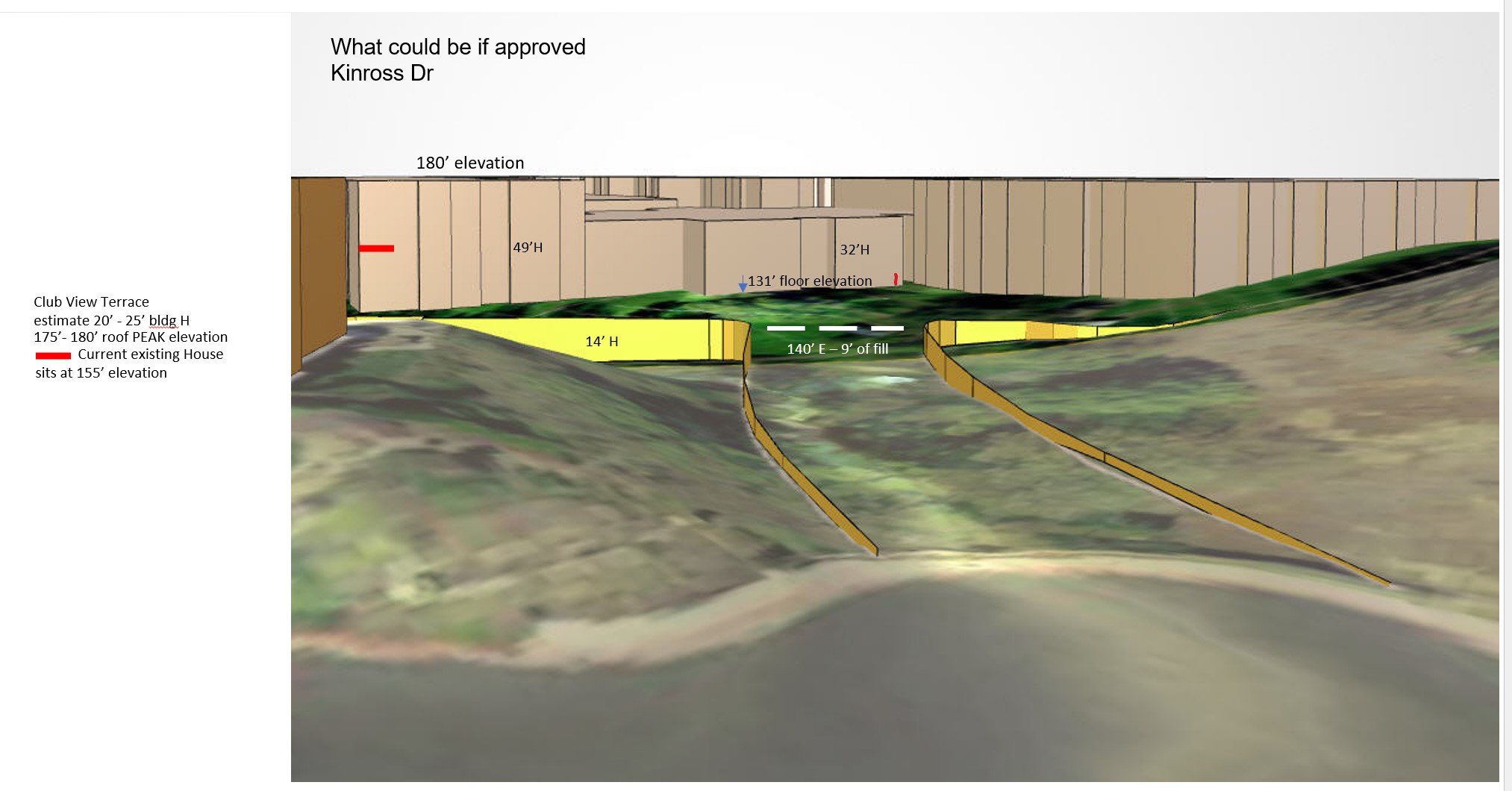
What will be if proposal is approved -red line indicates current hill heights 155'-159' elevation. Top of new building height will be 180' elevation.



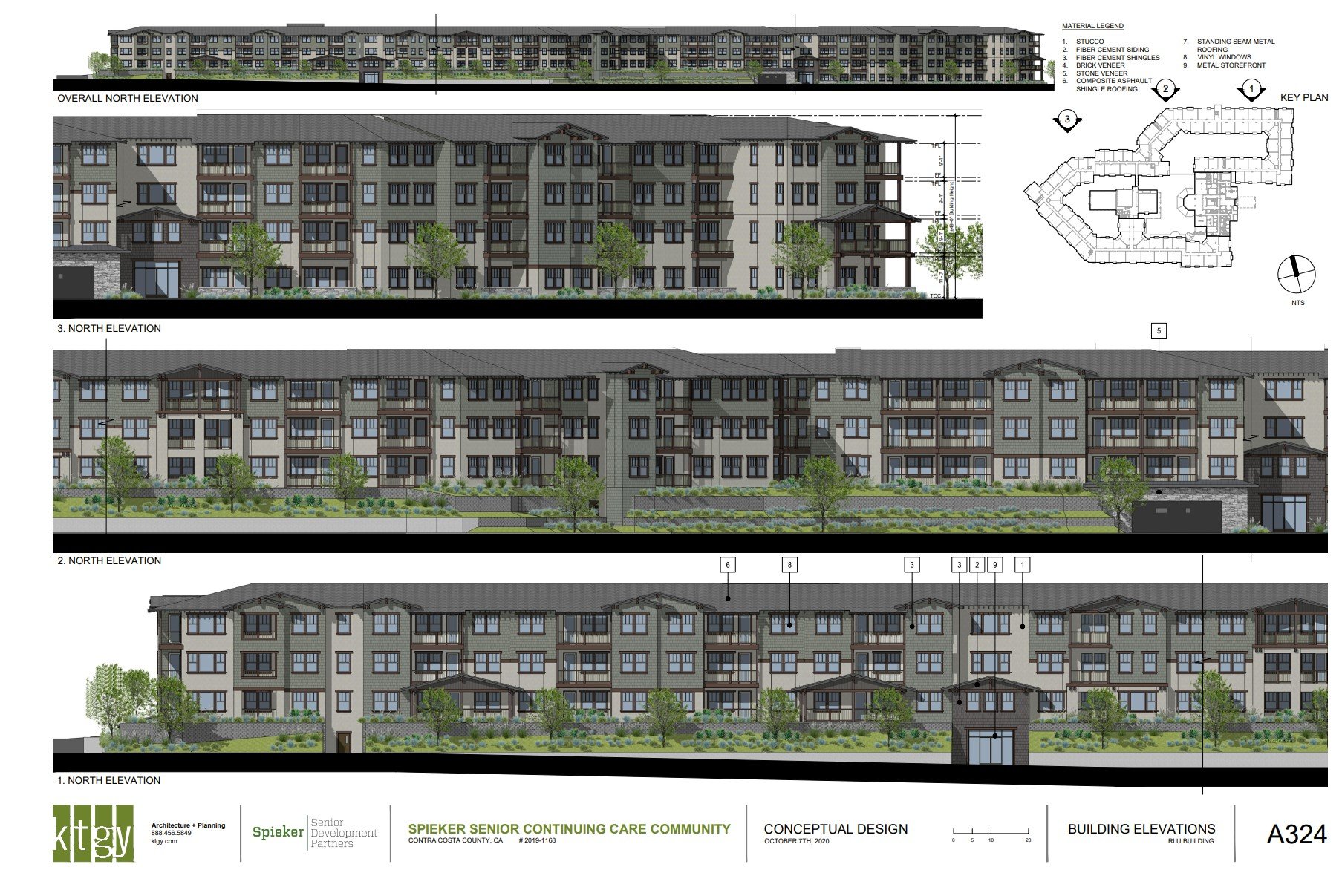
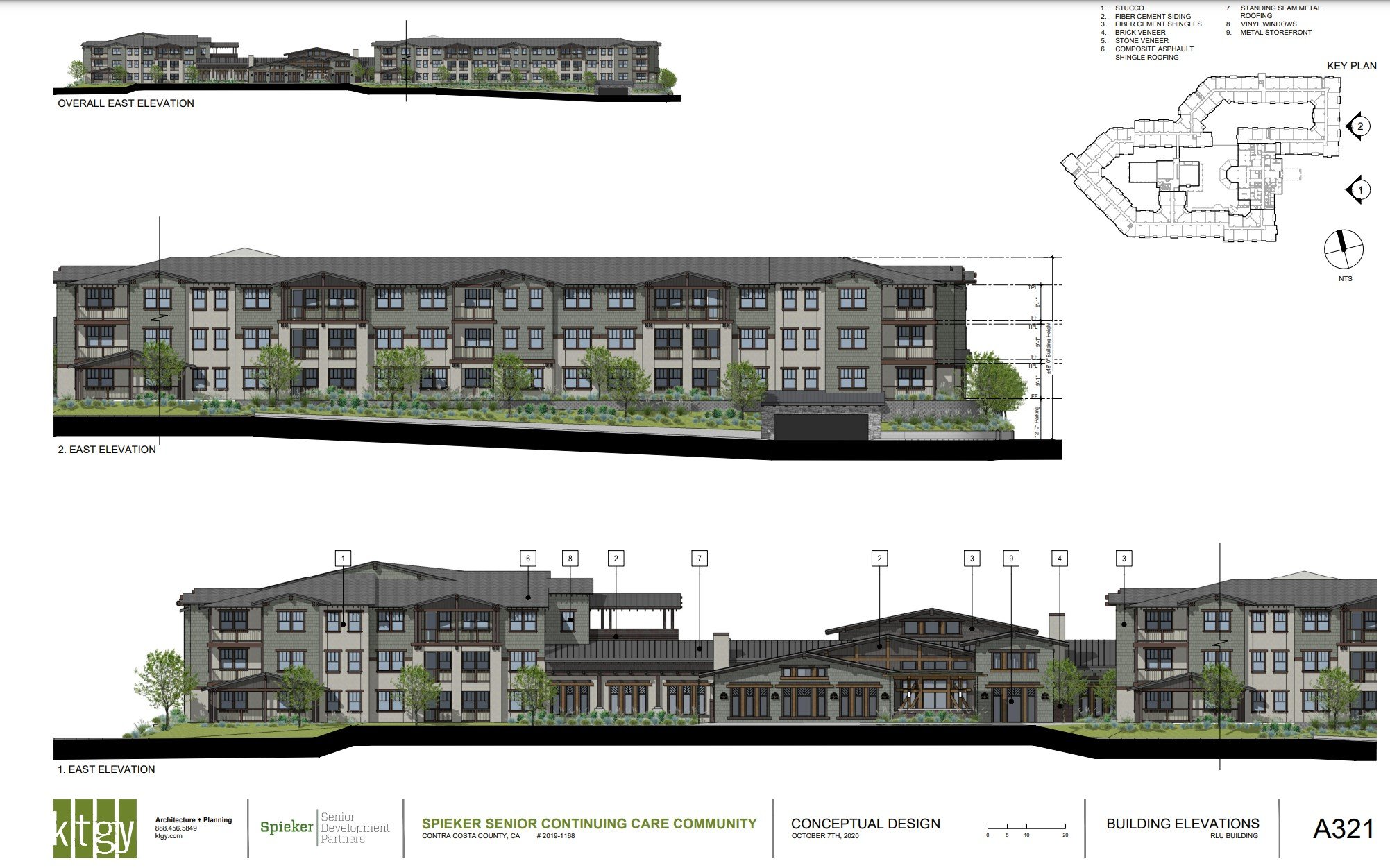
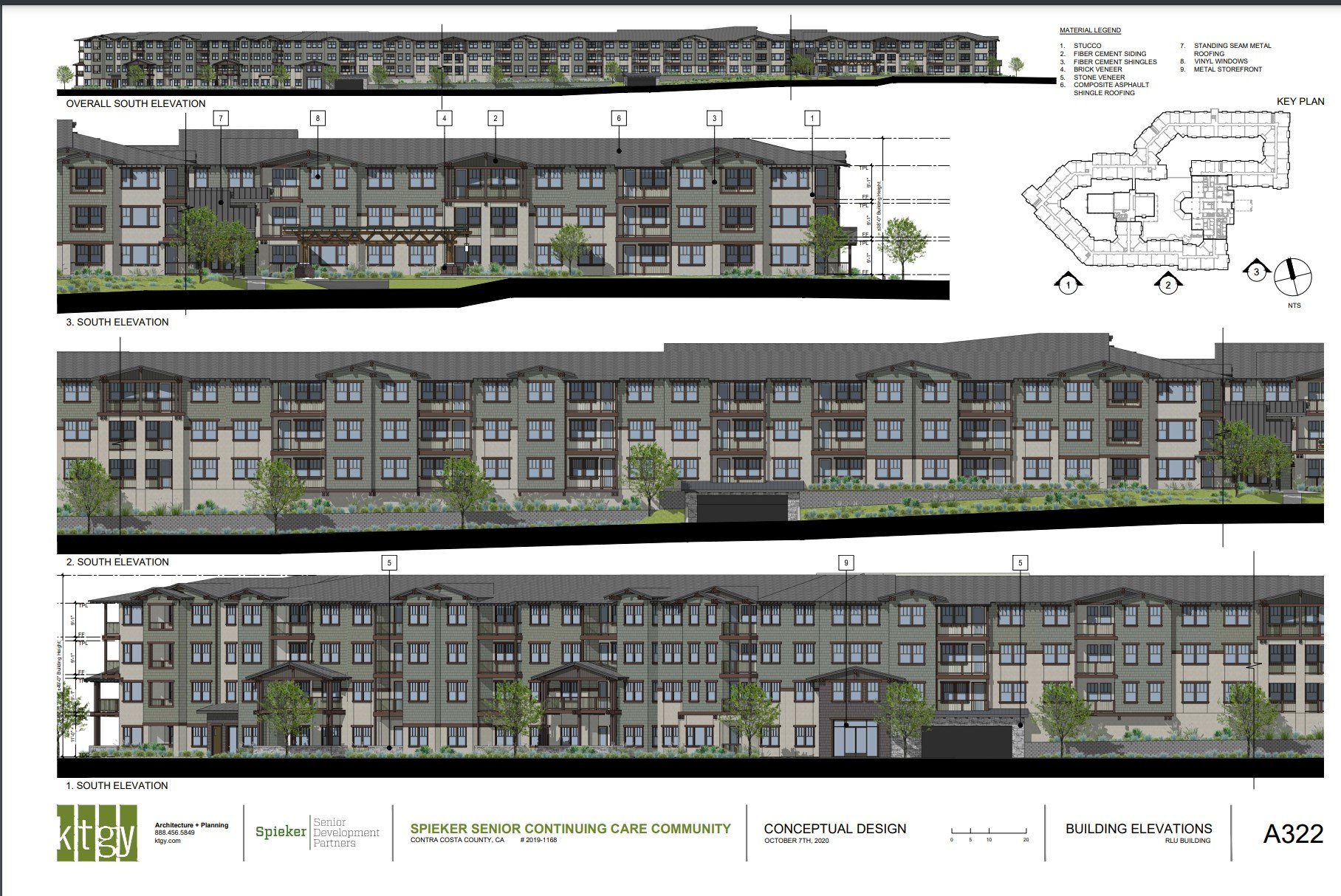

Developer's "sister" property at Stoneridge Creek, Pleasanton, CA (spk.com)

The Proposed Site Plan
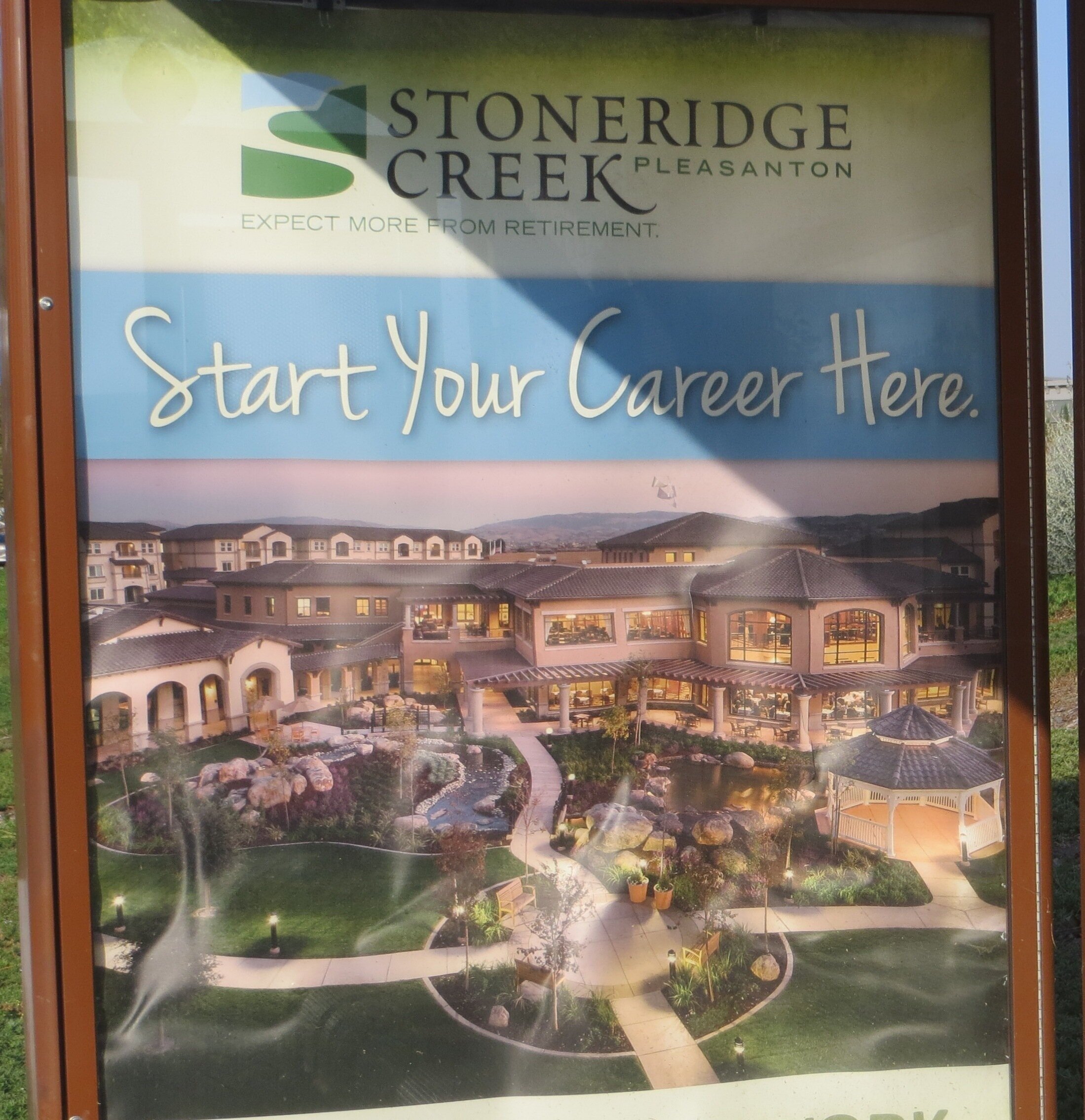
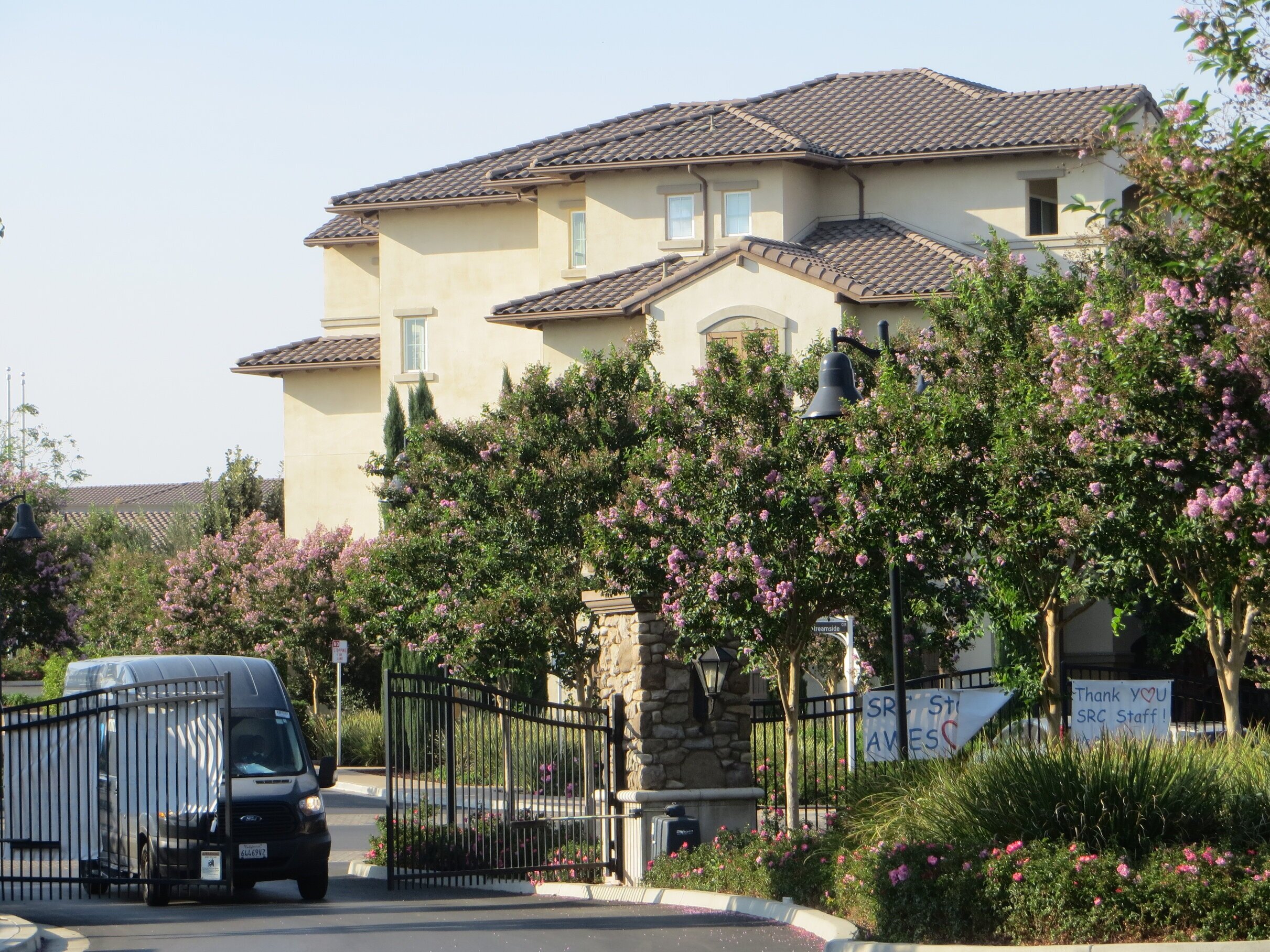
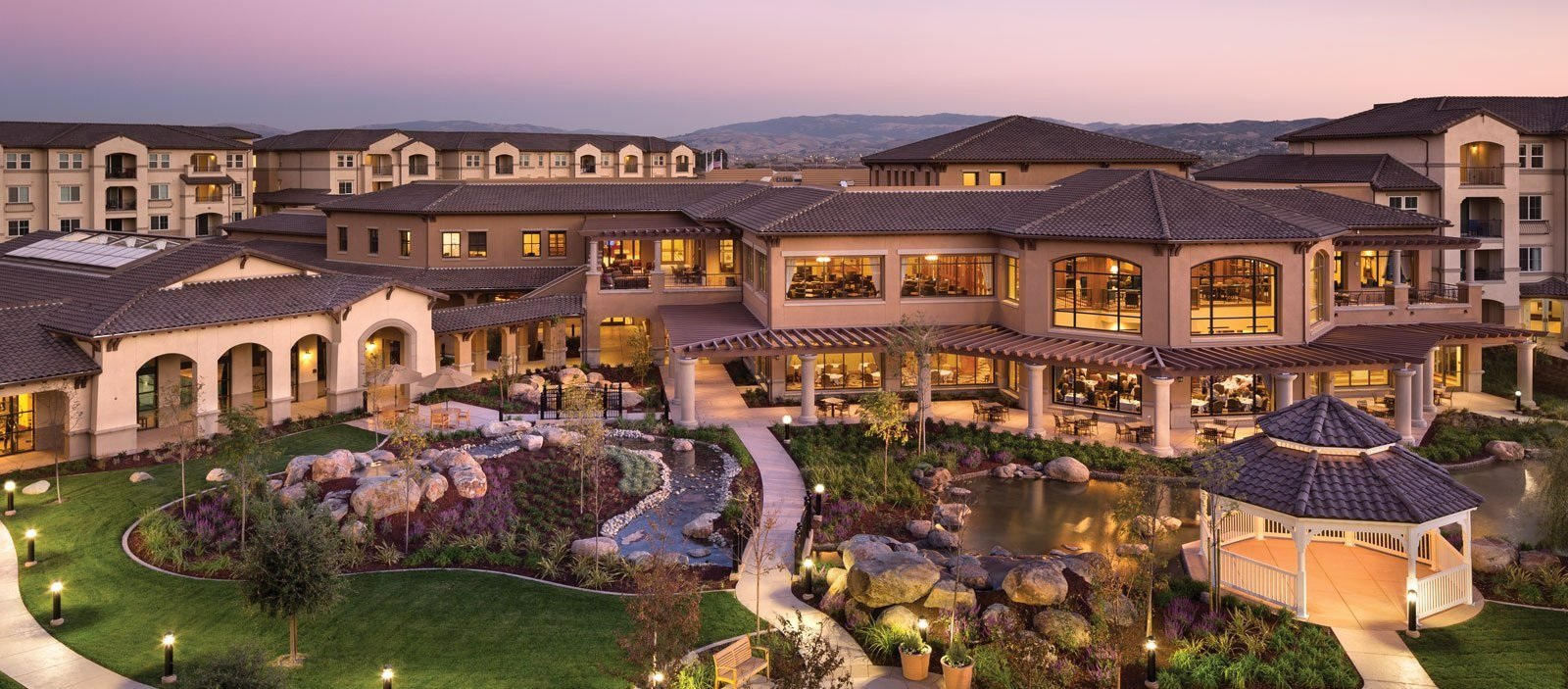
spk.com